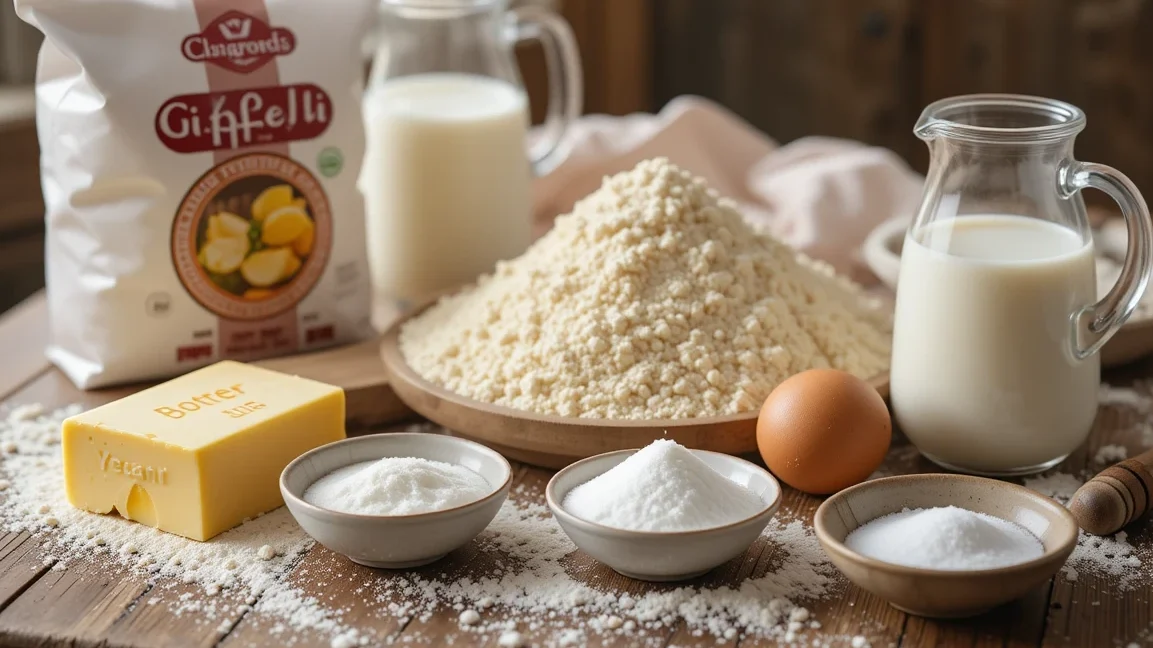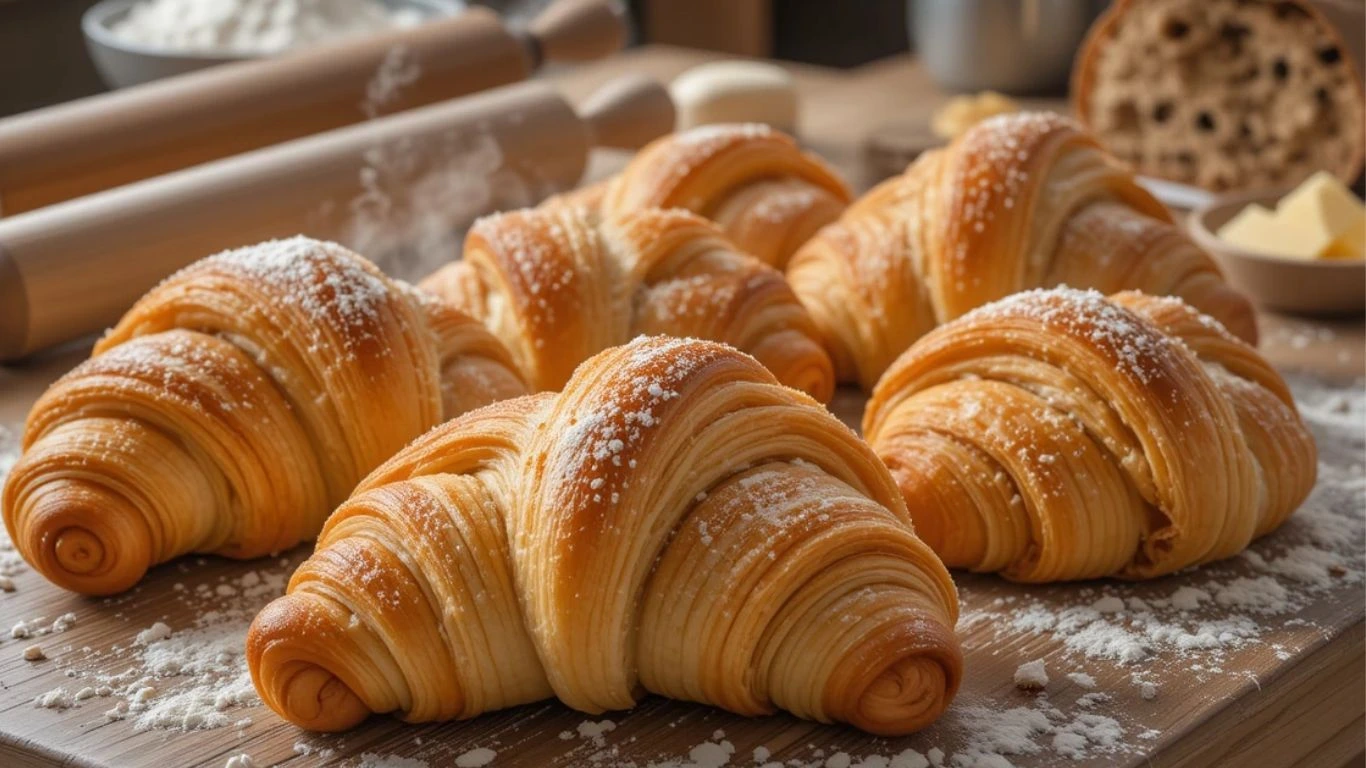There’s nothing quite like the aroma of freshly baked Gipfeli wafting through your kitchen. This flaky, buttery Swiss pastry is often compared to the French croissant but has its own unique charm. Whether you’re a baking enthusiast or a beginner looking to perfect your Gipfeli-making skills, this guide will walk you through seven essential tips to ensure your homemade Gipfeli turn out crisp, golden, and absolutely delicious.
By the end of this guide, you’ll understand how to make Gipfeli recipe from scratch, avoid common mistakes, and enjoy these pastries fresh out of your oven. Let’s get started!
Table of Contents
What is Gipfeli?
Gipfeli is a staple of Swiss bakeries, a crescent-shaped pastry with a flaky and airy texture. Unlike croissants, Gipfeli is often slightly denser and less buttery, making it a versatile choice for both sweet and savory variations.
Essential Ingredients for Authentic Gipfeli Recipe
| Ingredient | Quantity |
|---|---|
| Flour | 500g |
| Butter | 250g |
| Yeast | 10g |
| Sugar | 50g |
| Milk | 250ml |
| Salt | 5g |
| Egg (for wash) | 1 |

Choosing high-quality ingredients is crucial for achieving the perfect texture and taste. Always opt for fresh yeast and European-style butter for the best results.
7 Essential Tips for Mastering Homemade Gipfeli
Making homemade Gipfeli may seem like a challenge, but with the right techniques, you can achieve bakery-quality results in your own kitchen. Below, we expand on essential tips to ensure you master this delightful Swiss pastry.
1. Choose the Right Type of Flour
Flour plays a crucial role in determining the texture of your Gipfeli. The gluten content in different flours affects the final product’s consistency. Bread flour, with its high protein content, helps develop the necessary gluten structure, leading to a chewy yet structured pastry. However, combining bread flour with all-purpose flour creates a balanced texture, making the Gipfeli light and airy while maintaining its signature crispiness. Sifting the flour before use ensures an even distribution of dry ingredients, reducing the risk of clumping.
2. Master the Dough Preparation
A well-prepared dough is the foundation of perfect Gipfeli. Here are some crucial steps:
- Work the dough properly: Knead it until it reaches a smooth, elastic consistency.
- Resting time matters: Allow the dough to rest for at least an hour. This helps gluten formation and enhances the flavor.
- Avoid over-kneading: Excessive kneading leads to a tough texture, making it difficult to achieve the desired flakiness.
A well-rested dough is easier to roll out and shape, ensuring the layers remain distinct.
3. Perfecting the Butter Layering Process
Lamination is the technique responsible for the flaky, buttery layers in Gipfeli. To achieve optimal lamination:
- Keep the butter cold: Soft or melted butter ruins the layering process, leading to greasy pastries.
- Even rolling is key: Roll out the dough evenly before folding it over the butter block.
- Chill between folds: Refrigerate the dough between each fold to maintain its integrity.
- Repeat the process: Complete at least three folding and rolling cycles to develop delicate, crisp layers.
Patience during this step is crucial. Rushing the process or using warm butter can compromise the pastry’s structure.
4. Rolling and Shaping Gipfeli Properly
Achieving the perfect Gipfeli shape requires precision. Here’s how:
- Flatten the dough evenly to around 5mm thick.
- Use a sharp knife or pastry cutter to cut the dough into equal triangular pieces.
- Roll each triangle from the base to the tip, applying gentle pressure to maintain an even shape.
- Ensure the tip is tucked underneath to prevent unrolling during baking.
Uniformity in size allows for even baking and ensures a visually appealing final product.
5. Proofing at the Right Temperature
Proper proofing ensures that the dough rises correctly, contributing to a light and airy texture. Follow these guidelines:
- Maintain a warm, draft-free environment: A consistent temperature between 75–80°F (24–27°C) is ideal.
- Avoid over-proofing: Letting the dough rise too long can cause it to collapse in the oven.
- Cover the dough: Use a clean kitchen towel to prevent it from drying out.
Checking for readiness is simple: lightly press the dough with your finger.If it springs back slowly, it’s ready for baking.
6. Baking to Golden Perfection
Achieving the ideal Gipfeli texture depends on the right baking techniques:
- Set your oven to 375°F (190°C) for consistent baking.
- Create a humid baking environment: Placing a small dish of water in the oven or spraying water inside before baking helps develop a crispy exterior.
- Bake until golden brown: This typically takes 18–22 minutes, depending on your oven.
Rotating the baking tray halfway through ensures an even golden-brown color.
7. Final Touches for the Best Homemade Gipfeli Recipe
Adding the right finishing touches can elevate your Gipfeli:
- Egg wash for shine: Brush with an egg wash before baking for a glossy finish.
- Extra toppings: Sprinkle sesame seeds, almonds, or coarse sugar for added texture and flavor.
- Cooling time matters: Let the pastries cool for a few minutes before serving to enhance their flavor and texture.

Common Mistakes to Avoid When Making Gipfeli Recipe
Even experienced bakers make mistakes. Avoid these common pitfalls:
- Over-kneading the dough, which results in a dense texture.
- Using warm butter during lamination, leading to greasy and flat pastries.
- Skipping proper proofing, which affects the final rise.
- Baking at the wrong temperature, resulting in undercooked or soggy pastries.
How to Store and Reheat Homemade Gipfeli Recipe
Storage Tips:
- Keep the Gipfeli in a sealed container at room temperature for up to 2 days.
- Freeze unbaked Gipfeli for up to 3 months for fresh pastries anytime.
Reheating Instructions:
- Preheat your oven to 325°F (165°C).
- Heat for 5–7 minutes until warm and crispy.
FAQ: Common Questions About Homemade Gipfeli
1. What is the difference between Gipfeli and croissants?
Gipfeli, a Swiss pastry, is slightly denser and less buttery than a traditional French croissant, giving it a unique texture.
2. Can I make Gipfeli dough ahead of time?
Yes! You can prepare the dough and refrigerate it overnight to enhance the flavor and make handling easier.
3. How do I prevent my Gipfeli from becoming too dry?
Ensure you do not overbake them, and store them in an airtight container to retain moisture.
4. Can I add fillings to my Gipfeli?
Absolutely! Common fillings include chocolate, almond paste, or savory choices like cheese.
5. What is the best way to reheat Gipfeli?
Reheat in an oven at 350°F (180°C) for 5-7 minutes to restore crispness and warmth.
Conclusion
Mastering homemade Gipfeli takes practice, but with these seven essential tips, you can bake perfect, flaky pastries every time. Whether enjoyed plain, with a filling, or alongside your morning coffee, homemade Gipfeli are a true delight. Now it’s your turn give this recipe a try and share your results!

